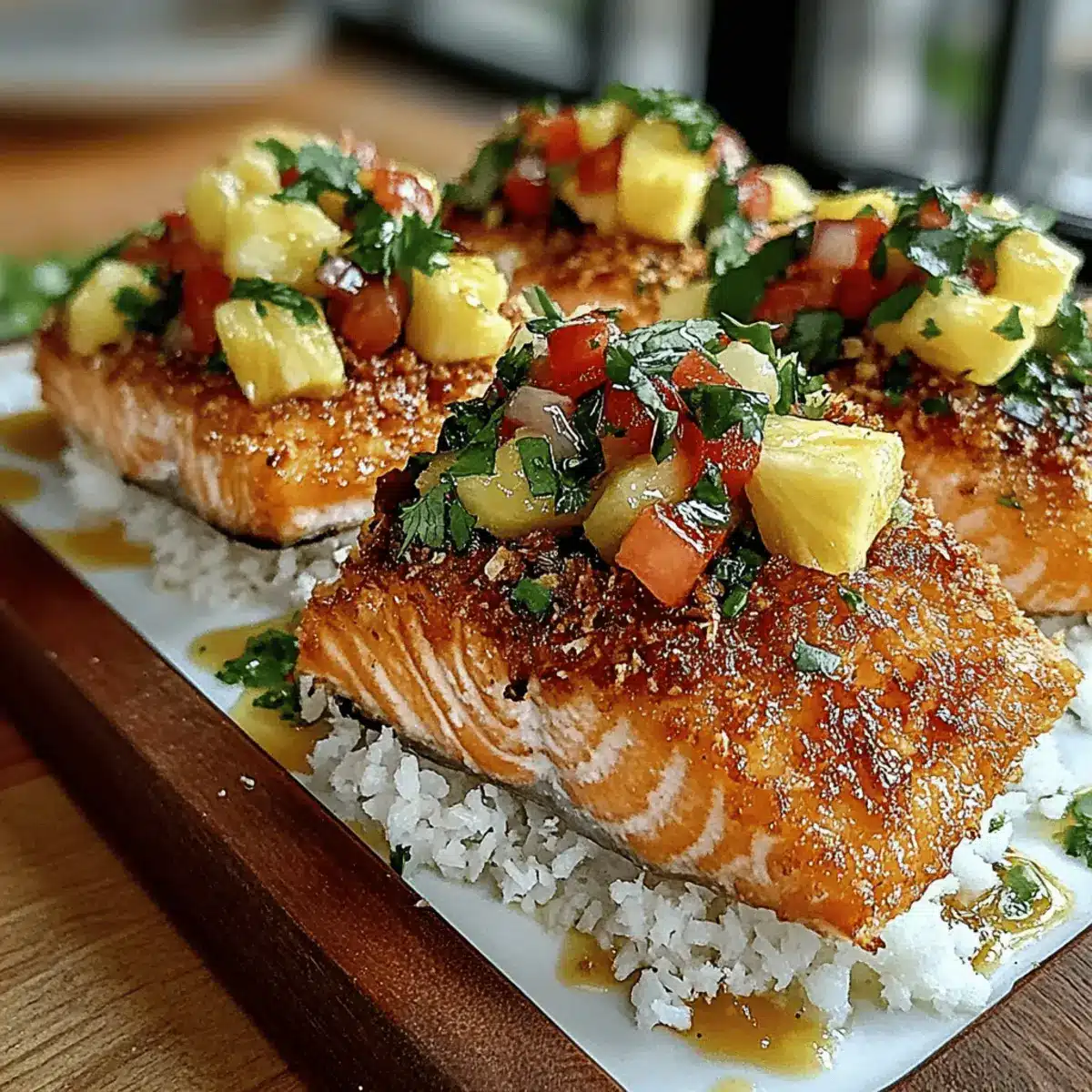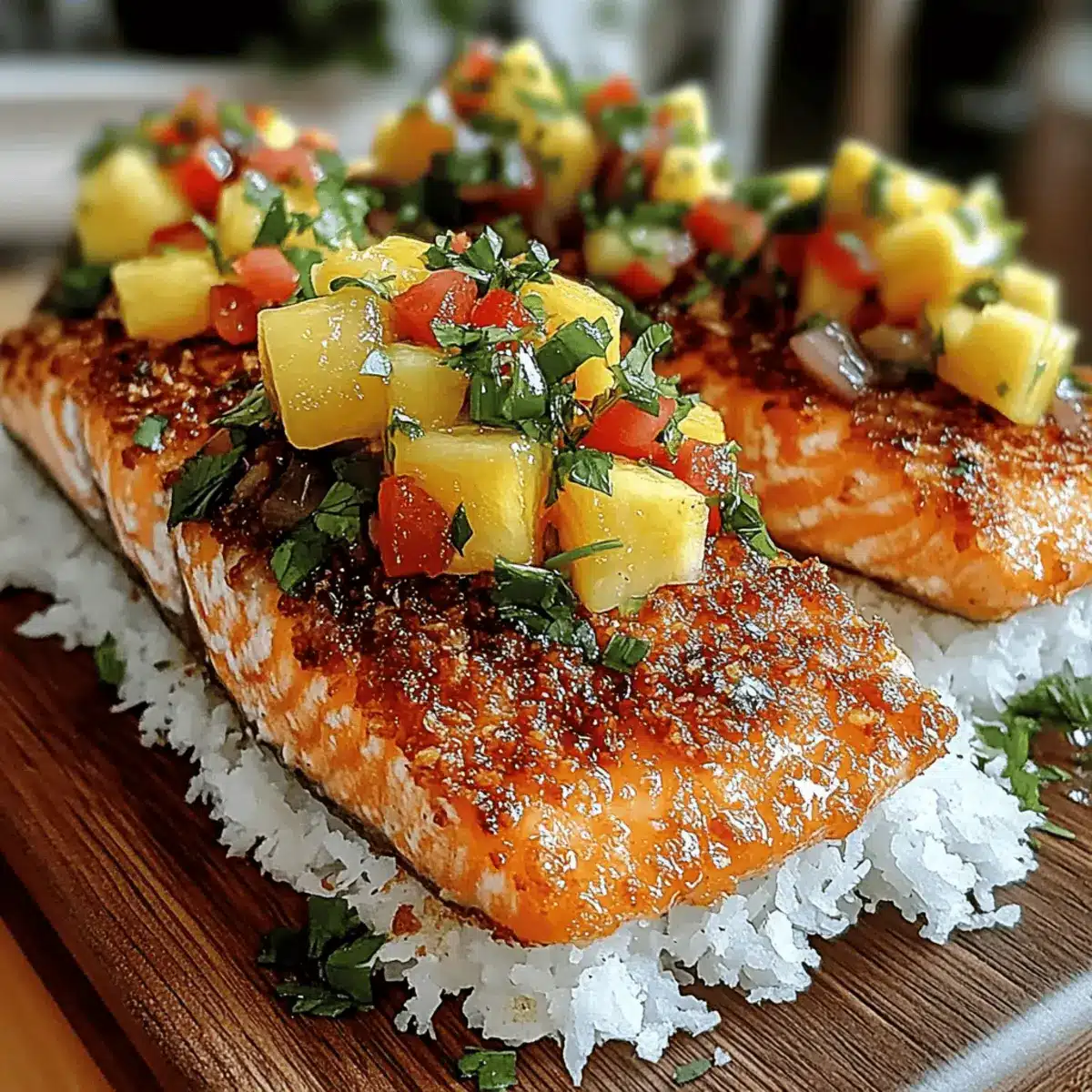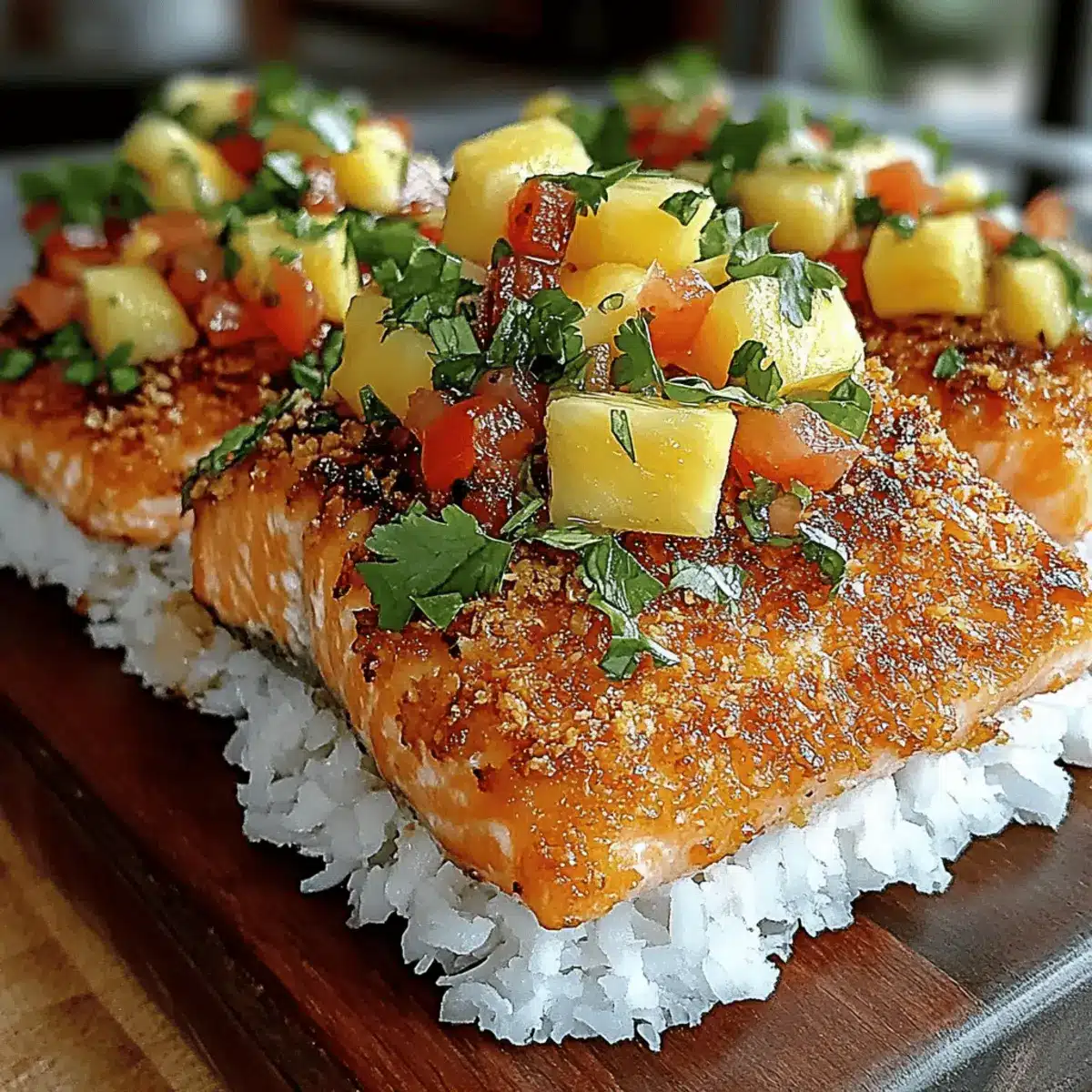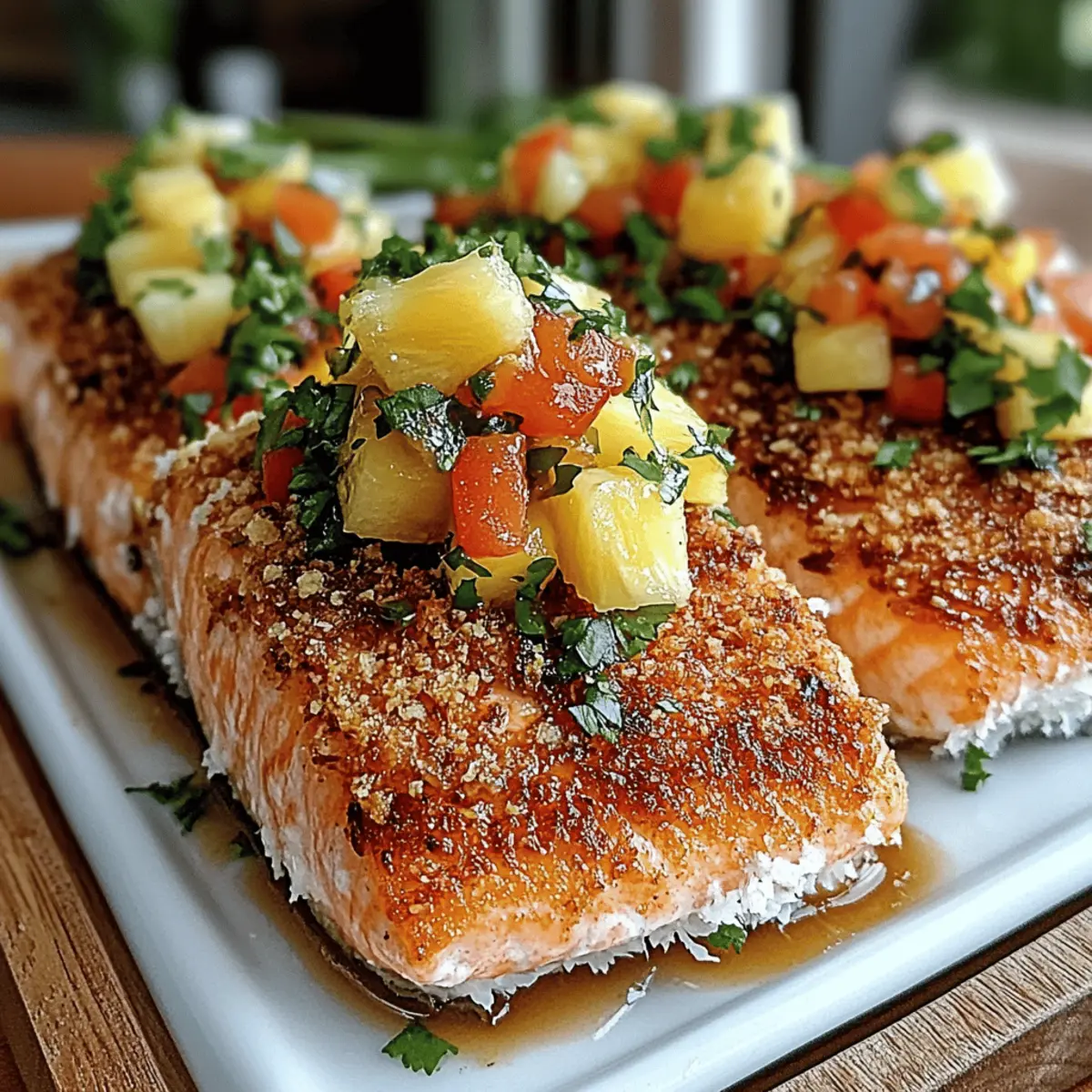Picture the sun setting over a shimmering ocean, where a tropical breeze carries the sweeter aromas of fresh pineapple and coconut. That’s the essence of my Coconut Crusted Salmon with Pineapple Salsa—an inviting dish that brings a taste of paradise right to your dinner table! Easy to make yet packed with flavor, this meal transforms tender salmon into a delightful experience with its crispy coconut crust and vibrant, zesty salsa. Not only is it a feast for the senses, but it’s also healthy and gluten-free, making it perfect for a casual weeknight dinner or an elegant gathering. The combination of juicy salmon and refreshing salsa is sure to leave you and your loved ones craving more. Curious about how to whip up this tropical delight? Let’s dive in!
Why is This Recipe a Must-Try?
Simplicity at its finest: With straightforward steps and basic ingredients, even novice cooks can impress with this tropical dish.
Flavor explosion: The fusion of crispy coconut with the sweet and tangy pineapple salsa creates a symphony of tastes that dance on your palate.
Healthy goodness: Rich in omega-3s and gluten-free, this meal appeals to health-conscious diners seeking nutritious options without sacrificing taste.
Versatile options: Whether you prefer it vegan with tofu or need a gluten-free alternative using ground almonds, there’s a version for everyone.
Crowd-pleaser: Serving this dish guarantees compliments! Pair it with jasmine rice or a fresh salad for an unforgettable dining experience. If you enjoy seafood, don’t miss out on our Cajun Grilled Salmon for another delightful option.
Coconut Crusted Salmon Ingredients
For the Salmon
• Salmon Fillets – Choose fresh salmon for the best flavor; frozen works too if fresh isn’t available.
• All-Purpose Flour – Helps the egg wash adhere; swap with cornstarch for a gluten-free option.
• Large Eggs – Acts as the binding agent for the crust; essential for a perfect coating.
• Coconut Oil (or Olive Oil) – Use for frying or baking; can be substituted with vegetable oil if needed.
For the Coconut Crust
• Unsweetened Shredded Coconut – Provides a delightful crunch and a hint of sweetness; unsweetened controls sugar content.
• Panko Breadcrumbs – Adds that light, crispy texture; substitute with gluten-free panko for gluten-free cooking.
For the Pineapple Salsa
• Pineapple – Offers sweetness and acidity; fresh pineapple is best, but canned works if drained.
• Red Bell Pepper – Adds vibrant color and a touch of sweetness; yellow or green peppers make great substitutes.
• Red Onion – Brings sharpness to the salsa; can swap for white or yellow onion in smaller amounts.
• Jalapeño – Gives a spicy kick; omit for milder flavor or replace with a bell pepper for no heat.
• Lime Juice – Brightens the salsa; lemon juice can be used as an alternative.
• Fresh Cilantro – Enhances freshness; feel free to substitute with parsley or leave it out if preferred.
• Salt – Essential for elevating flavors throughout the dish.
Dive into this delightful Coconut Crusted Salmon with Pineapple Salsa, and transform your meal into a tropical oasis!
Step‑by‑Step Instructions for Coconut Crusted Salmon with Pineapple Salsa
Step 1: Prepare the Salsa
Start by dicing fresh pineapple, red bell pepper, red onion, and jalapeño, then combine them in a bowl. Squeeze in lime juice and add chopped fresh cilantro, seasoning with a pinch of salt. Let this refreshing pineapple salsa sit at room temperature for 15–20 minutes to allow the flavors to meld beautifully.
Step 2: Set Up for Breading
While the salsa marinates, preheat your oven to 375°F (190°C) if you plan to bake the salmon. Prepare your breading station by arranging three shallow bowls: one with seasoned all-purpose flour, another with beaten eggs, and the last with a mixture of unsweetened shredded coconut and panko breadcrumbs.
Step 3: Bread the Salmon
Pat the salmon fillets dry with paper towels to ensure the crust adheres well. Dredge each fillet in the seasoned flour, shaking off any excess, then dip it into the beaten eggs, coating thoroughly. Finally, press the salmon into the coconut-panko mixture until evenly coated, ensuring a nice layer sticks to the surface.
Step 4: Cook the Salmon
For frying, heat coconut oil in a skillet over medium heat. Carefully place the breaded salmon fillets in the skillet and cook for about 3–4 minutes on each side, or until golden brown and cooked through. If baking, place the coated salmon on a lined baking sheet and bake for 15–20 minutes until the crust is golden and the salmon flakes easily.
Step 5: Serve
Once cooked, transfer the salmon fillets to plates and generously top each piece with the vibrant pineapple salsa. This Coconut Crusted Salmon with Pineapple Salsa pairs beautifully with steamed jasmine rice or a fresh green salad, transforming your meal into a tropical experience that’s both delightful and satisfying.
Make Ahead Options
These Coconut Crusted Salmon with Pineapple Salsa are perfect for meal prep enthusiasts looking to simplify weeknight dinners! You can prepare the pineapple salsa up to 24 hours in advance by mixing the diced pineapple, red bell pepper, onion, jalapeño, lime juice, and cilantro, then refrigerating it to enhance the flavors. For the salmon, bread it and store it in the fridge for up to 3 days; just be sure to place it in an airtight container to maintain its quality. When you’re ready to cook, simply bake or fry the salmon as instructed. This way, you’ll enjoy restaurant-quality results with minimal effort during your busy evenings!
Coconut Crusted Salmon with Pineapple Salsa Variations
Feel free to take this dish to the next level with these delightful twists that add flavor and cater to different dietary preferences!
-
Gluten-Free: Substitute all-purpose flour with cornstarch and use gluten-free panko or ground almonds for the crust.
-
Dairy-Free: This recipe is naturally dairy-free, so no changes are needed to enjoy its healthful goodness.
-
Vegan Option: Swap out the salmon for firm tofu. Bread it just like the salmon, and you’ll have a wonderful plant-based dish.
-
Tropical Twist: Enhance the salsa by adding diced mango or a splash of coconut milk for a creamier texture and tropical sweetness.
-
Heat Level: For a spicier kick, add more jalapeño to the salsa or include a dash of cayenne pepper to the crust mixture.
-
Herb Swap: If cilantro isn’t your favorite, consider using fresh mint or basil in the salsa for a different herbal note.
-
Crunch Factor: You can add chopped nuts like macadamia or cashews to the coconut-panko mixture for added crunch and a hint of nuttiness.
-
Fish Variation: Try using other fish like halibut or cod instead of salmon for a completely different fish experience—but keep an eye on cooking times!
If you love seafood, don’t forget to check out our delicious Cajun Grilled Salmon for another fantastic option!
Tips for the Best Coconut Crusted Salmon
-
Pat Dry Your Salmon: Ensuring the salmon is patted dry is crucial; this helps the coating stick better for a crispier crust.
-
Let Salsa Rest: Allowing the pineapple salsa to sit at room temperature for 15-20 minutes enhances the flavors; don’t skip this step!
-
Avoid Overcrowding: If frying, avoid overcrowding the pan. Cooking in batches ensures even heat distribution and prevents the crust from becoming soggy.
-
Internal Temperature Check: Use a thermometer to check that the salmon reaches an internal temperature of 145°F (63°C) for perfect doneness.
-
Substitutions: Remember, you can easily adapt this recipe! Ground almonds or gluten-free panko work for a gluten-free option while keeping the delicious Coconut Crusted Salmon intact.
How to Store and Freeze Coconut Crusted Salmon
Fridge: Store leftover Coconut Crusted Salmon in an airtight container for up to 2 days. Reheating gently in the oven will help maintain its crispy texture.
Freezer: If you want to keep it longer, wrap the cooled salmon fillets tightly in plastic wrap and then aluminum foil. They can be frozen for up to 3 months.
Reheating: For best results, thaw in the fridge overnight before reheating in the oven at 350°F (175°C) until heated through, about 10-15 minutes.
Salsa Storage: Store leftover pineapple salsa in the fridge in a sealed container for up to 3 days. Stir before serving as flavors may settle.
What to Serve with Coconut Crusted Salmon with Pineapple Salsa
A tropical meal deserves a splash of creativity—pair your dish with these delightful companions for a complete dining experience!
-
Steamed Jasmine Rice: Light and fragrant, it complements the crispy salmon while soaking up the zesty flavors of the salsa.
-
Mixed Green Salad: A crisp, fresh salad dressed with a citrus vinaigrette adds a refreshing crunch to balance the richness of the salmon.
-
Grilled Asparagus: Tender and lightly charred, asparagus adds a smoky note that contrasts beautifully with the sweet pineapple salsa.
-
Coconut Rice: Infused with coconut milk, this dish mirrors the flavors in the salmon and enhances the tropical vibe of your meal.
-
Quinoa Salad: Packed with nutrients and a chewy texture, a quinoa salad with diced vegetables and a squeeze of lime mirrors the salsa’s vibrancy.
-
Tropical Fruit Salad: A medley of mango, kiwi, and berries gives a refreshing and colorful side that ties in perfectly with the dish’s tropical theme.
-
Sparkling Water with Lime: A bubbly drink with a squeeze of lime cleanses the palate and adds a splash of festivity to your dining experience.
-
Key Lime Pie: End the meal on a sweet note with this tangy dessert, perfectly matching the citrus notes of the pineapple salsa, leaving everyone satisfied!
Coconut Crusted Salmon with Pineapple Salsa Recipe FAQs
How do I select the best salmon for this recipe?
Absolutely! When choosing salmon, look for bright, vibrant colored fillets with a fresh ocean smell. If possible, ask your fishmonger about the source for quality assurance. Fresh salmon is best, but if you don’t have access to it, frozen salmon will work too; just ensure it’s properly thawed before cooking.
What is the best way to store leftover Coconut Crusted Salmon?
Leftover Coconut Crusted Salmon can be stored in an airtight container in the refrigerator for up to 2 days. To maintain its crispy texture, gently reheat it in the oven at 350°F (175°C) for about 10-15 minutes until warmed through. Avoid the microwave if you want to keep that lovely crunch!
Can I freeze the salmon, and if so, how?
Absolutely! To freeze, let the cooked salmon cool completely, then wrap each fillet tightly in plastic wrap followed by aluminum foil. This helps to prevent freezer burn. You can store it in the freezer for up to 3 months. When you’re ready to enjoy, thaw it overnight in the fridge and reheat as mentioned earlier.
What should I do if the coconut crust is not sticking to the salmon?
If you find that your coconut crust isn’t adhering well, try patting the salmon fillets dry with a paper towel before breading. This step is crucial for helping the flour and egg wash firmly stick to the salmon. Also, ensuring that the coating is pressed firmly onto the fish will give you that perfect crispy crust!
Is this dish suitable for those with allergies?
While this Coconut Crusted Salmon is naturally gluten-free and dairy-free, it’s important to note that some individuals may have allergies to fish. Always check for cross-contamination if you’re preparing this dish for people with specific dietary restrictions. For a vegan option, use firm tofu, prepared similarly to the salmon, which can still deliver that delightful crunch!

Coconut Crusted Salmon with Pineapple Salsa: A Tropical Delight
Ingredients
Equipment
Method
- Prepare the salsa by dicing pineapple, red bell pepper, red onion, and jalapeño. Combine in a bowl and add lime juice, cilantro, and salt. Let sit for 15-20 minutes.
- Preheat the oven to 375°F (190°C). Set up a breading station with bowls of seasoned flour, beaten eggs, and a mixture of coconut and panko breadcrumbs.
- Pat the salmon fillets dry, dredge in flour, dip in eggs, and coat with the coconut-panko mixture.
- For frying, heat coconut oil and cook salmon for 3-4 minutes on each side until golden brown. For baking, place on a lined sheet and bake for 15-20 minutes.
- Serve the salmon topped with pineapple salsa, ideally paired with jasmine rice or a fresh salad.




